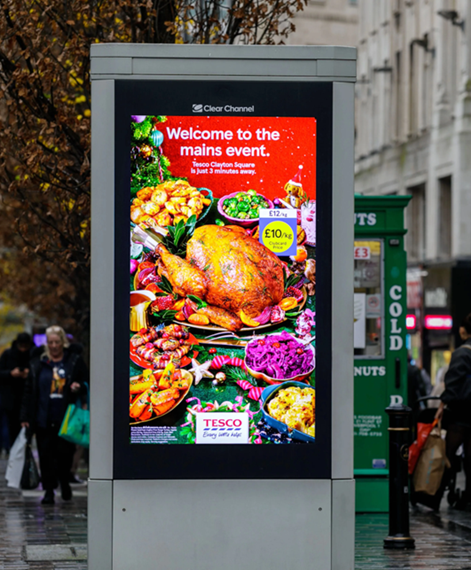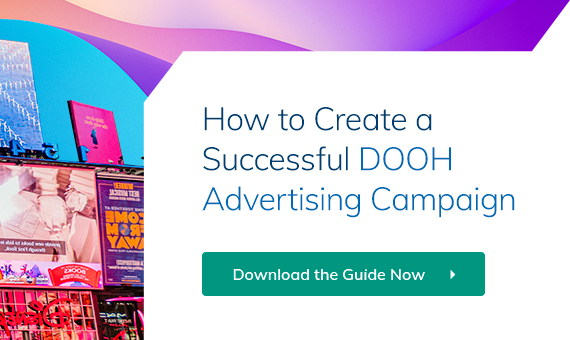Digital Out-Of-Home or DOOH advertising uses prominent digital screens, billboards, and physical installations in public spaces to reach audiences outside of the home in high-traffic areas.
For advertisers, this can be a cost-effective way to reach a large audience and drive action, especially when compared to traditional static OOH displays.
Recent research from oOh! Media indicates that brands incorporating DOOH into their marketing mix see an average return on investment (ROI) increase of 39% compared to those relying solely on TV advertising.
Adding dynamic content to the DOOH mix leverages real-time data and the visual power of video, animation, and interactive technologies to enable marketers to deliver messages that match the surrounding environment and audience behavior, making ads more engaging and impactful.
How Dynamic DOOH Content Benefits Agencies
Dynamic DOOH campaigns enable agencies to conduct highly targeted marketing that leverages data-driven insights to produce messaging that is adaptable in real time. Advertisers can also target specific audiences based on location, time of day, weather, or even real-time events. This approach increases audience engagement, while the technology involved provides greater measurability, and smoother integration with other digital marketing channels.
A study by DoubleVerify reveals that 69% of consumers are more likely to look at an ad if it is relevant to what’s going on in the environment around them.
Data-driven insights also help agencies optimize their budgets by allocating spend where ROI is highest. Advertisers can therefore focus their spending on high-performing locations, times, or audience segments to maximize the impact of their campaigns.
With no need for physical materials like paper or vinyl, DOOH platforms offer reduced costs in production and distribution. Real-time update capabilities enable dynamic DOOH to further reduce costs and accelerate the pace at which agencies can launch and adjust campaigns.
Programmatic DOOH or pDOOH platforms use algorithms to automate the buying, placement, and optimization of media inventory, enabling a more precise and efficient allocation of advertising budgets. pDOOH platforms also leverage real-time data to target specific audiences at optimal times, maximizing the impact of each ad dollar the agency spends.
Some Successful Dynamic DOOH Campaigns
The evolution of dynamic DOOH content is a relatively recent development in an area of marketing that is itself quite new. However, there are already some stellar examples of how brands have managed to create flexible, adaptable campaigns that can respond to changing environments and customer behaviors.
For example, Heathrow Express used real-time data to show ads with cost and time comparisons to their target audience, as well as the environmental impact of each mode of transport. The campaign boosted passenger journeys by 9%, revenue by 7%, and market share by 2%, compared to the previous year. Customer satisfaction increased by 4% and awareness by 6%.
Elsewhere, global fast food chain McDonald’s used live weather data from the UK’s Met Office to trigger a dynamic advertising campaign that turned its menu items into weather icons. In hot weather, for instance, the brand used a French fry dipped in ketchup to represent a thermometer.
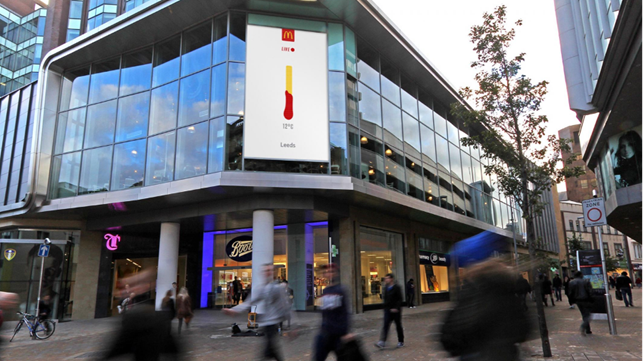
[Image source: grandvisual.com]
For weekly weather data, the dynamic DOOH displays featured a cheeseburger to symbolize sunshine, an upturned box of fries signifying rain, and steaming coffee for clouds.
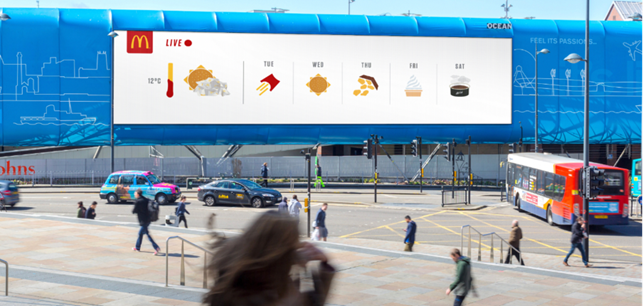
[Image source: outsmart.org.uk]
In another campaign, soft drinks giant Coca-Cola used data analytics to create a cross-channel DOOH campaign which invited customers to share their holiday wishes on digital screens, mobile devices, and social media. The campaign displayed over 100,000 wishes and reached over 10 million people, with 1.5 million engagements.
During the 2023 festive season, UK supermarket chain Tesco monitored what consumers at different locations were searching for using the Google API. The brand used this information to create customized messaging and images for Christmas merchandise relevant to each locality.
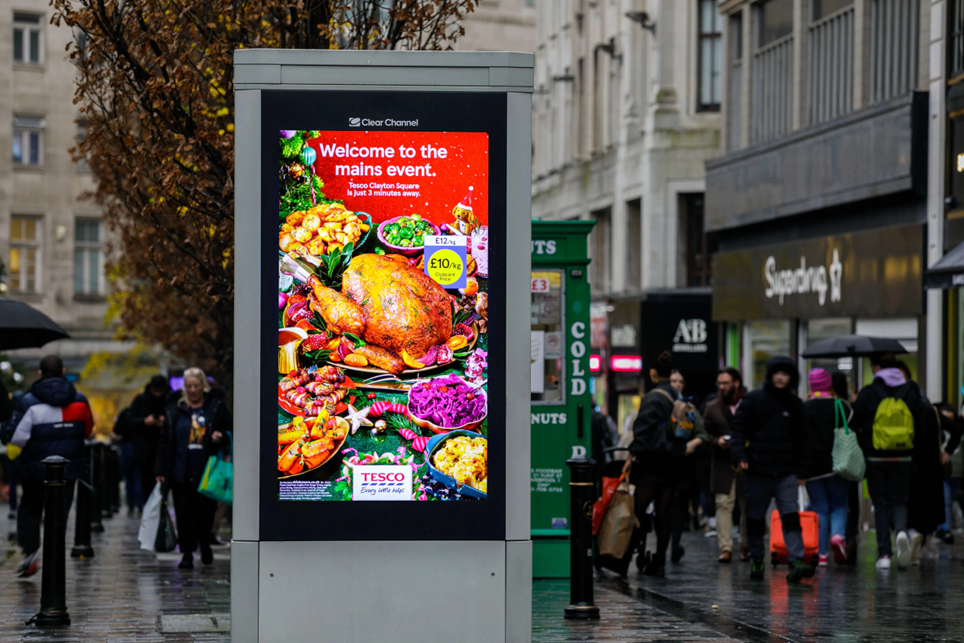
[Image source: Cloudinary.com]
Best Practices for Dynamic DOOH
The examples above illustrate some of the best practices that agencies can adopt to effectively implement dynamic DOOH campaigns.
Here’s how you can replicate their successes with your own DOOH campaigns.
Audience Targeting
Develop a full understanding of the target audience. Agencies can use first-party data – i.e., information obtained from direct interaction with a customer base, or third-party data, which is information relevant to the target consumer, but aggregated by reliable data brokers. Demographics, buying preferences, movement patterns and customer behaviors are all relevant for creating adaptable content to present offers that resonate deeply with the audience’s current needs and interests.
Marketers can combine location intelligence from mobile device IDs with geo-fencing technologies to create virtual boundaries within the vicinity of a DOOH ad. Crossing these boundaries can trigger specific display options. Advertisers can also use location intelligence to retarget individuals with additional digital ads across mobile and social platforms.
Design and Display of Dynamic Content
Creative designers can use photos, illustrations, short form video, animation, text, and audio to create visually impactful and engaging content. Displays may also incorporate interactive elements like QR codes, touchscreens, and Augmented Reality (AR).
Agency marketers may use dayparting methodologies to schedule client ads that resonate with target audience movement and activities at various times of day. Dynamic DOOH content may also take account of local context, such as cultural and current events to maintain contextual relevance for ads in each locality.
Campaign Management and Monitoring
Use a programmatic DOOH platform, to gain access to real-time data for creative optimization based on real-time events and environmental conditions. Analytics and reporting tools available from a good pDOOH platform will also provide the information you need to monitor campaign performance and optimize ad placements.
Get Started with Dynamic DOOH with The Neuron
Specializing exclusively in pDOOH, The Neuron empowers agencies to automatically activate campaigns based on user actions, time, weather, inventory changes, or trends for timely, relevant ads. The platform offers a unique bidding technology which utilizes a smarter, more dynamic algorithm to deliver higher-impact ad placements at lower costs for clients.
To learn more about how The Neuron can help drive ROI for your agency with dynamic DOOH campaigns, get in contact today.
